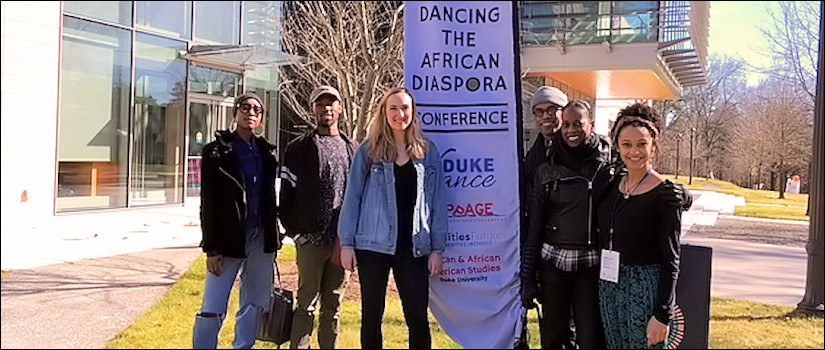On stage --- Stories of the Origins and Experiences of African Americans
Tanya Wideman-Davis and Thaddeus Davis, the prolific dance duo, and AFAM Studies’ newest faculty, recently took their show on the road to Duke University in Durham, NC and Swarthmore College in Pennsylvania. Accompanying them -- three university dance students John Green, Maria Maccaroni and Petra Morgan.
The troupe performed vignettes from the acclaimed novel “Cane,” written by Harlem Renaissance author Jean Toomer. The vignettes revolve around the origins and experiences of African Americans in the United States.
Created by technologists, dancers and visual artists, the set design is digitally constructed with a program called ISADORA. As the dancers are performing in real time, a live video feed is projected onto pre-recorded video on the Cane Field set. Sound is generated by movement during the performance to create a “real-time, constructed responsive environment. The production was conceived by Thomas F. Defrantz and created in collaboration with Wideman-Davis Dance and performed by Thaddeus Davis, Tanya Wideman-Davis, Jade Solomon-Curtis, John Green, Maria Maccaroni and Petra Morgan.
Tanya Wideman-Davis, assoc. professor, talks about their road trip, and the experience:
What is it about “Cane” that inspired you to create this production?
“Tommy asked us to create the choreography for a new production of CANE. He had been doing the work for a few years prior to our collaboration, and he was in the original manifestations. He was seeking a more expansive production and asked us if Wideman Davis Dance would be interested in collaborating.”
Why take this performance on the road?
“The benefit of taking productions on the road is to broaden your audience base, which gives you a broader perspective on the work. Touring is also a way of connecting with communities outside of your own through residency activities.”
Why did you select Green, Maccaroni and Morgan to work on “Cane?”
“We chose to work with the Maria, John. and Petra because they are students that have shown a level of maturity in the work we have created on the students and the only way for them to actualize as dancers is to give them the opportunity to delve into the professional performance and art-making field.”
Wideman-Davis joined the AFAM Studies family last fall. What are three main benefits of merging AFAM with the Dance Program?
- “African American dance contributions are often invisible in the American and global
dance markets. Being in African American studies gives us the opportunity to create
a course that centers the black experience in dance as a way of interrogating the
global dance industry.”
- “Our dual appointment provides AFAM and dance students the opportunity to collaborate
and take courses with a population that they would probably categorize as an unlikely
mix. For us, it is a natural integration and evolution. Since our dual appointment,
I have received comments of skepticism from dance students such as ‘how is that going
to work?’ My comment is ‘sign up for a course and find out.’”
- “Students also need to have the ability to study and theorize about African American’s contributions to dance, which is vast and regenerative. We are so proud to be a part of developing this track of study and look forward to the interdisciplinary collaborations that will follow.”
What’s next for Wideman-Davis Dance?
“We have several Wideman Davis Dance projects that will be done from now to fall 2018 but they won’t utilize the students. There is a fall 2018 “CANE” tour to Montpellier France, which is in the development phase now.
